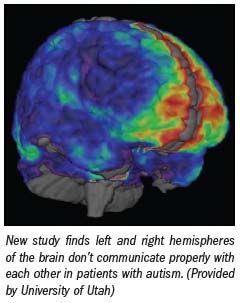FMRI shows connections missing in autistic brains
A new study using functional MRI shows the right and left hemispheres of the brain don’t communicate well in patients with an autistic condition.
A new study using functional MRI shows the right and left hemispheres of the brain don’t communicate well in patients with an autistic condition. The study is yet another in a series that suggests autism may be a disorder of connectivity. Such information could ultimately aid in the development of earlier, more effective treatments by distinguishing types of autism and allowing physicians to get to the root of the disease.
University of Utah medical researchers used fMRI to identify regions where the left and right hemispheres of the brains of autistic patients do not properly communicate with one another.
Those regions are in “hot spots” associated with functions such as motor skills, attention, facial recognition, and social functioning-all areas in which abnormal behavior is often noted in autistic patients. Scans of people without the disorder did not show the same deficits (Cerebral Cortex doi:10.1093/cercor/bhq190).
“One of the biggest problems with autism is that until recently we really didn’t understand the mechanism of the disease in the brain,” said Dr. Jeffrey Anderson, lead author of the study and a neuroradiologist at the university. “It’s hard to design treatment strategies, drugs, or other therapies if you don’t understand exactly what is wrong.”

The current study starts to show exactly what is wrong. In their investigation of 53 high-functioning male subjects with autism and 39 typically developing male subjects, the researchers found decreased interhemispheric correlations between homologous voxels in some regions of the brain in the autism sample.
The investigators constructed spatial maps of correlation between homologous voxels in each hemisphere and found significantly reduced interhemispheric correlation specific to regions relating to autistic behavior. Those areas include the: sensorimotor cortex, anterior insula, fusiform gyrus, superior temporal gyrus, and superior parietal lobe.
“Once we have hard, reproducible differences in the brain, there is so much more we can do,” said Anderson, who is also an assistant professor of radiology at the university. “We can trace these connectivity disturbances back and test what is wrong with the cells of the brain or the wiring that causes them.”
The researchers can also use the differences in connectivity to identify genes that may be abnormal.
“Ultimately we can work out the whole disease mechanism by tracing backward from known ‘hard’ abnormalities,” he said. “We have a handhold to grab onto and work with.”
If fMRI is combined with other tests, such as differences in the diffusion of water, or differences in size of brain regions, a composite test can be created to effectively classify individual patients.
“Many investigators are actively working on this right now,” Anderson said.
An autism expert from the University of California, San Francisco (UCSF) said Anderson’s research adds support to the importance of connectivity in the etiology of autism.
“We are still a long way from a diagnostic test-this research will need to be replicated-but they had a good sized sample and multiple sites were involved,” said Dr. Robert Hendren, vice chair of the psychiatry department and director of child and adolescent psychiatry at UCSF.
This study moves researchers closer to defining subtypes that may help them identify useful treatment targets, he said.
If investigators are able to diagnose autism early, it can aid treatment for the patient.
“The most effective treatments for autism right now involve adaptation strategies that are most effective if begun early,” Anderson said. “Delaying diagnosis until after a child begins school, for example, can limit options for treatment that may help a child better prepare for school, social interactions, and managing their environment at home.”
Expanded FDA Approval Allows Use of Pluvicto Prior to Chemotherapy in Patients with mCRPC
March 28th 2025Recent research demonstrated a 59 percent reduced risk of progression or death with the radioligand therapy Pluvicto in comparison to a change of androgen receptor pathway inhibitor (ARPI) for patients with metastatic castration-resistant prostate cancer (mCRPC).
The Reading Room Podcast: Current Perspectives on the Updated Appropriate Use Criteria for Brain PET
March 18th 2025In a new podcast, Satoshi Minoshima, M.D., Ph.D., and James Williams, Ph.D., share their insights on the recently updated appropriate use criteria for amyloid PET and tau PET in patients with mild cognitive impairment.
GE HealthCare to Launch PET MPI Agent Flyrcado at ACC Conference
March 28th 2025The positron emission tomography myocardial perfusion imaging (PET MPI) agent, which offers a significantly higher half-life than other cardiac PET agents, was recently granted pass-through payment status by CMS that will go into effect on April 1, 2025.
New Collaboration Offers Promise of Automating Prior Authorizations in Radiology with AI
March 26th 2025In addition to a variety of tools to promote radiology workflow efficiencies, the integration of the Gravity AI tools into the PowerServer RIS platform may reduce time-consuming prior authorizations to minutes for completion.